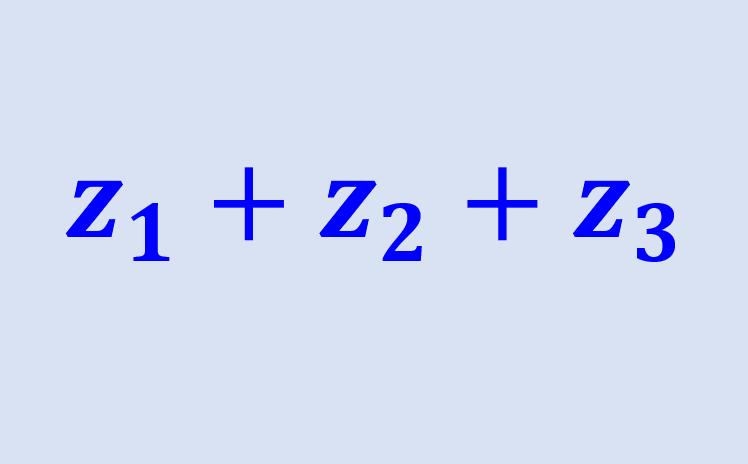Complex numbers are numbers that have a real part and an imaginary part. These numbers have the form a+bi, where a and b are real numbers and “i” is the imaginary unit, defined as the square root of negative one. We can perform various operations on these numbers, including addition, subtraction, multiplication, and division.
Here, we will learn how to solve addition of complex numbers. In addition, we will look at several examples with answers to fully master this topic.
How to solve addition of complex numbers?
To add two or more complex numbers, we simply have to add the real and imaginary parts separately. This is similar to adding polynomials, where we add like terms. Therefore, if we have the numbers $latex z_{1}=a+bi$ and $latex z_{2}=c+di$, their addition is equal to:
| $latex z_{1}+z_{2}=(a+c)+(b+d)i$ |
We see that the real part of the resulting number is the sum of the real parts of each complex number and the imaginary part of the resulting number is the sum of the imaginary parts of each complex number. That is, we have:
$latex Re(z_{1}+z_{2})=Re(z_{1})+Re(z_{2})$
$latex Im(z_{1}+z_{2})=Im(z_{1})+Re(z_{2})$
This applies to any number of complex numbers that we are adding.
Addition of complex numbers – Examples with answers
The process of solving additions of complex numbers mentioned above is used to solve the following examples. Each exercise has its respective solution, but it is recommended that you try to solve the exercises yourself before looking at the answer.
EXAMPLE 1
Add the numbers $latex z_{1}=15+7i$ and $latex z_{2}=4+8i$.
Solution
We have to identify the real and imaginary parts of the numbers and add them separately. Therefore, we have:
$latex z_{1}+z_{2}=15+7i+4+8i$
$latex =(15+4)+(7+8)i$
$latex =19+15i$
EXAMPLE 2
Add the numbers $latex z_{1}=-25+14i$ and $latex z_{2}=13-15i$.
Solution
We group the real and imaginary parts to add separately:
$latex z_{1}+z_{2}=-25+14i+13-15i$
$latex =(-25+13)+(14-15)i$
$latex =-12-i$
EXAMPLE 3
Add the numbers $latex z_{1}=2+6i$, $latex z_{2}=-5-4i$ and $latex z_{3}=4+2i$.
Solution
Here, we have three complex numbers, but we have to follow the same procedure. We simply group the real and imaginary parts to add them separately:
$$z_{1}+z_{2}+z_{3}=2+6i-5-4i+4+2i$$
$latex =(2-5+4)+(6-4+2)i$
$latex =1+4i$
EXAMPLE 4
Add the numbers $latex z_{1}=-5+3i$, $latex z_{2}=-12+11i$ and $latex z_{3}=7-7i$.
Solution
The process to follow is the same no matter how many complex numbers we have. We simply group the real and imaginary parts to add them separately:
$$z_{1}+z_{2}+z_{3}=-5+3i-12+11i+7-7i$$
$latex =(-5-12+7)+(3+11-7)i$
$latex =-10+7i$
EXAMPLE 5
If we have the numbers $latex z_{1}=a+7i$, $latex z_{2}=-4+bi$ and $latex z_{3}=4+2i$, what is the value of a and b if we have $latex z_{3}=z_{1}+z_{2}$?
Solution
Adding the real and imaginary parts of the numbers $latex z_{1}$ and $latex z_{2}$ separately, we have:
$latex 4=a-4$
⇒ $latex a=8$
$latex 2=7+b$
⇒ $latex b=-5$
EXAMPLE 6
If we have the numbers $latex z_{1}=a-5i$, $latex z_{2}=7+bi$ and $latex z_{3}=-10-4i$, what is the value of a and b if we have $latex z_{3}=z_{1}+z_{2}$?
Solution
Adding the real and imaginary parts of the numbers $latex z_{1}$ and $latex z_{2}$ separately, we have:
$latex -10=a+7$
⇒ $latex a=-17$
$latex -4=-5+b$
⇒ $latex b=1$
Addition of complex numbers – Practice problems
Test your knowledge of the addition of complex numbers to solve the following problems. Select an answer and click “Check” to verify that you chose the correct answer.
See also
Interested in learning more about operations with complex numbers? Take a look at these pages:




